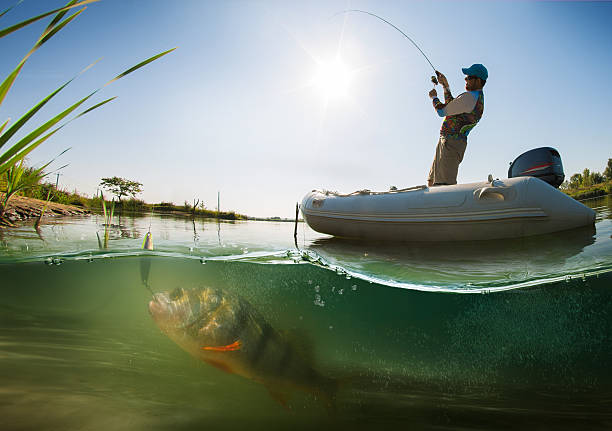Maximize your pond’s potential: Strategies to stock fish this spring

COLUMBIA, Mo. — Managing a pond or lake for sport fishing takes time, resources and a year-round commitment. Timing is crucial for many pond and lake management practices.
The approaching spring is an ideal time in Missouri to evaluate and determine if ponds need to be stocked or restocked, said Robert Pierce, associate extension professor in fisheries and wildlife at the University of Missouri.
Pierce said proper planning can increase the likelihood of good fishing opportunities and a healthy pond that meets management objectives.
Missouri pond owners should take three key steps when preparing to stock or restock ponds with fish this spring.
1. Determine your management objectives and assess the environmental conditions of the pond.
Will your desired fish population thrive? It depends on the size, structure and age of the pond. Shallow ponds are prone to fish kills caused by low oxygen, especially during winter and summer, and muddy ponds can lead to stunted fish growth. In addition, it’s important to consider water quality, food availability and vegetation control before purchasing fish for stocking.
The Missouri Department of Conservation’s Missouri Pond Handbook offers helpful tips for estimating pond size, and MU Extension’s Pond Management Calendar, at extension.missouri.edu/g9418, has information to help time various management practices and stocking regimes.
2. Stock the appropriate fish species.
MU Extension’s guide for managing ponds and lakes, at extension.missouri.edu/g9475, provides detailed recommendations on stocking fish in Missouri ponds and lakes. Additionally, the Missouri Department of Conservation offers recommendations on stocking the appropriate combination of fish species and sizes for a balanced population within your pond. For older ponds, this means taking inventory of the present fish population and their condition; owners of newly constructed ponds should be thoughtful when stocking for the first time.
Pond owners have several species to select from:
Largemouth bass work well in stocked ponds. They are a predatory fish and eat small fish, frogs, crawfish and insects. Because of their willingness to fight, they create a sport fishing challenge.
Bluegill sunfish are popular for catching and cooking. They consume microscopic plants, insects, snails, crayfish and small fish. Largemouth bass will eat bluegill, but natural reproduction tends to sustain bluegill populations. Bluegill and largemouth bass provide the basis for a sustainable fishery in Missouri ponds. Stocking rates depend on the productivity of the pond, but, generally, stock at a ratio of 500 bluegill to 100 largemouth bass per acre. Although bluegill can be stocked in ponds during spring or fall, it is often preferable to stock smaller fingerlings in fall so they have a chance to grow before you stock largemouth bass the following spring.
Redear sunfish and bluegill sunfish can be included in the stocking as they eat snails, and their young can be part of largemouth bass diets.
Fathead minnows can be stocked at 3 pounds per acre to provide an additional source of forage.
Channel catfish are part of largemouth bass diets, so frequent restocking (every two to three years) is necessary. Catfish consume crayfish, fish or commercial feed. Although catfish are not necessary to balance bass and bluegill populations in your pond, they provide additional fishing opportunities. Catfish can spawn in most ponds, but 8- to 10-inch fingerlings need to be restocked yearly in ponds with balanced bass and bluegill populations, as bass quickly consume smaller fingerlings.
Grass carp are an option for ponds in need of vegetation control. However, they are prolific and can overeat, causing environmental concerns.
3. Support Missouri’s aquaculture industry.
As owners take inventory of their pond’s ecosystem and determine the appropriate species for stocking, MU Extension’s Ryan Milhollin encourages them to consider supporting the state’s growing sport fish industry. Milhollin and a team of professionals studied Missouri’s aquaculture industry and developed resources, including demand opportunities and business models, for those interested in an aquaculture enterprise. Visit http://muext.us/AquacultureLinks.
“Our marketing study found that a large portion of the state’s aquaculture producers focus on pond and sport fish stocking, and many sell directly to consumers,” said Milhollin in a press release. “Working with a local fish producer can be a win-win for the industry and local pond owners.”
In 2020, the Missouri Department of Conservation published a list of Missouri fish producers who raise species suitable for the state’s ponds. Milhollin encourages pond owners to connect with a producer near their area to discuss pond stocking needs.
Missouri pond owners are encouraged to greet spring with a plan for stocking or restocking their ponds. For additional information about aquaculture and fisheries in the Show-Me State, reach out to the MU Extension aquaculture and fisheries team or Lincoln University’s aquaculture program.
University of Missouri Extension offers producers a range of decision-making tools and workshops to support farm business management and agricultural landowner decisions. Learn more at www.muext.us/AgBusiness, and find us on Facebook at www.facebook.com/AgBusinessMwww.facebook.com/AgBusinessMUU.
Miss Clipping Out Stories to Save for Later?
Click the Purchase Story button below to order a print of this story. We will print it for you on matte photo paper to keep forever.

